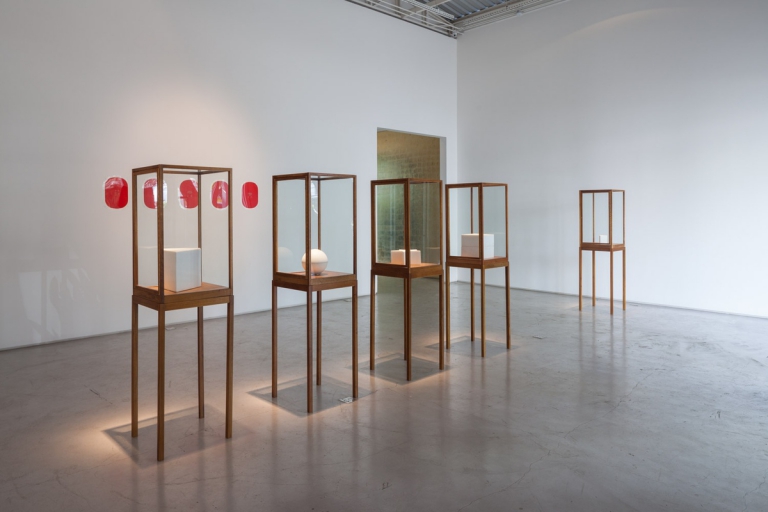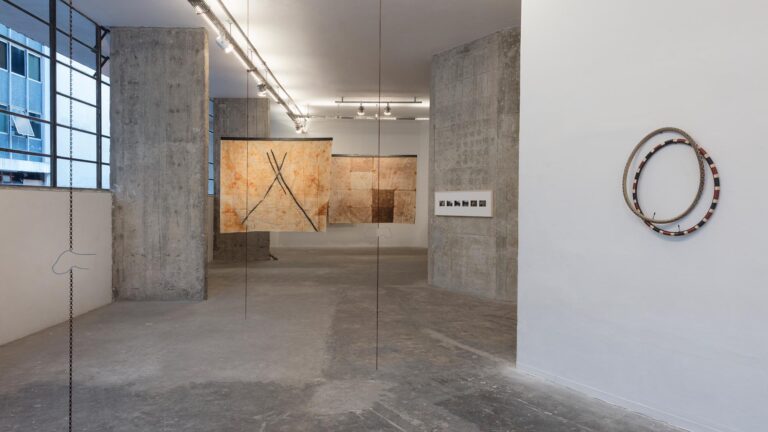Artist: Rodrigo Garcia Dutra
Exhibition title: Honi Soit Qui Mal Y Pense
Venue: BFA, São Paulo, Brazil
Date: February 26 – March 28, 2015
Photography: Images courtesy of the artist and BFA, São Paulo
The exhibition Honi Soit Qui Mal Y Pense (shame on him who thinks evil of it) by Rodrigo Garcia Dutra presents a series of new works produced in situ. Several years of studying and working in Britain have given form to the production of Garcia Dutra, an artist born into a family of mestizo origins with Indigenous, African, Portuguese and Belgian roots.
The production process for this show was unleashed during a ceremony in England where Garcia Dutra observed groups of English people dressed for a Peruvian ritual. From that moment onwards Garcia Dutra continued to develop the research previously started in Marrakesh, inspired by the sidewalk patterns on Jamaq el Fna Square, a street fair operating 24/7 and a metaphor for the global markets of today.
As in previous projects of the artist, there is a set of hybrid sources of inspiration present in the works on view. These culminate in formal exercises that are derived from reality, concrete things, indexes that can be considered cartographic works rather than mere representations. Upon his return to Brazil, Garcia Dutra has participated in Ayahuasca rituals, healing processes and moments of communion. The works presented in Honi Soit Qui Mal Y Pense (shame on him who thinks evil of it) discuss the recovery of ancestral spirits as well as transcendental moments in search to clarify contemporaneity that, one could believe, has already exhausted itself. While indigenous populations preserve the Ayahuasca ceremonial to connect with a spiritual universe where no analogy to the romantic scheme of the Western world exists, they also consider it a “teaching plant” that helps to understand our subconsciousness. Departing from his own dreams and visions the paintings here represent the new as a construction on top of what already exists.
The Kené patterns designed by the Kaxinawa / Huni kuin from the skin of python snakes form a sort of primer. Other graphical abstractions evoke the phenomena of nature such as butterfly wings, the eyes of a parakeet, the jaguar’s paw, among others. Akin to the python snake that reveals possible paths, Garcia Dutra materializes the experiences he has been pursuing, on this ocassion overlapping the ancestral wisdoms with the aesthetics of modern Brazilian architecture. Within an essentially animistic thinking, a universe where everything has spirit, both plants and animals and man, Garcia Dutra’s work conjures mestizo languages debating ceremonies, rituals and the forces of nature. Snakes, serpents and anacondas are represented in the paintings, sacred beings with the capacity to teach, heal, protect and open new routes of life for us. These possible lines are also relayed within the video Fluidics (2015), which, in a language characterized by geometric abstraction, relates the particular site of the gallery on Avenida Rebouças with the multiple river branches submerged beneath the city of São Paulo. Thus Honi Soit Qui Mal Y Pense (shame on him who thinks evil of it) turns center stage allowing the viewer to situate him and herself within an anthropological logic, lending the possibility to position ourselfes at the crossroads between traditional rituals and the contemporary city.














